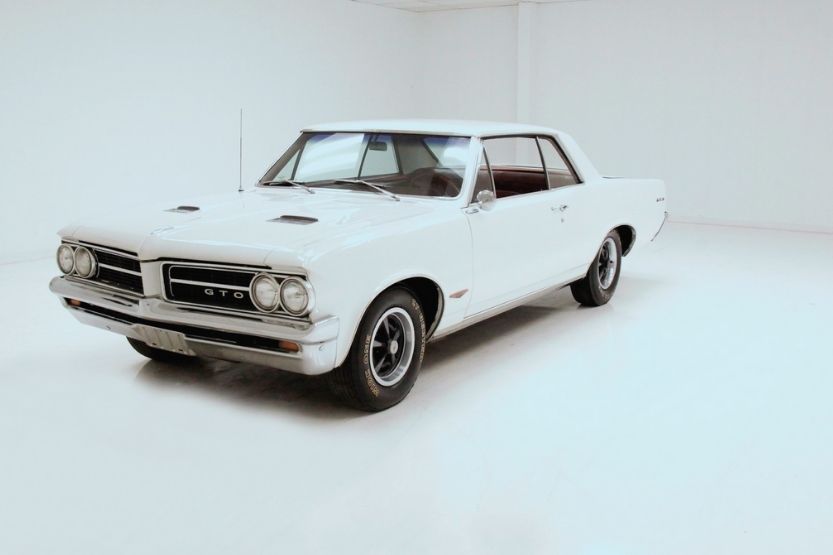Ask car enthusiasts what they think about when they hear “GTO” and watch as their ears perk up. What does GTO stand for anyway?
“GTO” stands for “Gran Turismo Omologato” in the motoring world. When loosely translated from Italian, it means a homologated grand touring car. Generally, a GTO is a car officially recognized for high-speed and long-distance racing. If you see a car with these three letters in its name, you deal with a street-legal racecar.
Read on to learn more about what GTO stands for and what cars display in these prestigious letters.
What Does GTO Stand For?

Racing Class for Street-legal Cars with a Limited Production Run
The literal meaning of GTO is “Gran Turismo Omologato,” which is Italian for “Grand Touring Homologation.” This is a racing class for street-legal cars with a limited production run. What does GTO mean on a car? This means that the cars are technically racecars built for the road.
Not One-off Race Cars
GTO cars are not one-off race cars like those used for Daytona or F1 racing. Homogulation is when the FIA, or the Federation Internationale de l’Automobile, discusses the GTO badge requirements.
Essentially, the car must meet specific specifications and reach the minimum number of cars produced and sold. The latter has recently been set low, allowing cars with limited production runs to pass.
GTO Meaning in Modern Internet Lingo
On an unrelated note, GTO has also found its way into modern internet lingo. What does GTO mean in text and Instagram? It means “Get Thee Out,” an SFW version of GTFO. You can use this acronym in a friendly manner or a sarcastic tone.
What Are Homologated Cars?
Homologation is not limited to GTOs only. Companies can also use it for standardizing production cars. However, it is only that GTO cars must pass stricter criteria.
Homologation is used to describe an independent committee’s entire vehicle approval process.
Getting this approval means it is government-certified to enter the automotive market. The car needs to undergo stringent tests to determine it has passed the minimum standard requirements.
Why Is Vehicle Type Homologation Important?
Vehicle homologation provides a variety of benefits, both for the carmakers and the component manufacturers, including:
- Gaining access to target markets legally can further lead to higher sales.
- Ensures the prompt delivery of vehicles to customers
- Avoids the hassles of penalties and fines due to non-compliance and/or vehicle recalls
- Boosts the brand’s reputation among potential customers and vehicle regulators because it essentially ensures vehicle safety
Homologation standardizes the automotive industry, not just the car racing scene. It ensures the strict application of all safety standards to guarantee the safety of the riding public.
What Was the Pontiac GTO?
Most Famous Car with GTO Certification
Probably the most famous car that got GTO certification is the Pontiac GTO. It is also the one that often comes to mind when they hear those three letters. The development of the first Pontiac GTO occurred when General Motors banned the production of racing cars in 1963.
Up until that point, Pontiac was almost exclusively devoted to producing cars that would decimate opponents on the race track. Because of this sudden development, Pontiac had to find a way to differentiate itself from the other GM brands.
John DeLorean Led the Production
The production was led by the legendary John DeLorean, which was the creator of the iconic DeLorean. The Pontiac design team was charged with coming up with a new, powerful, and fun car.
Based on the 1964 LeMans Coupe Prototype
DeLorean thought it would be good to base the new design on the 1964 LeMans Coupe prototype. After that, they would slap a 389 cubic inches (cu. in) V8 in it. This gave the LeMans a huge upgrade in power and handling. It also resulted in it becoming the first GTO.
Became One of the Most Legendary Cars to Come Out of Pontiac’s Manufacturing Plant
It later became one of the most legendary cars to ever come out of Pontiac’s manufacturing plant. However, the first launch of the GTO was quite rough.
First, DeLorean’s team violated the long-standing mandate of the GM. This is that their vehicles must have 10 pounds of weight for every cubic inch displacement of the engine.
However, the engineering team found a loophole. It turned out that the mandate only applied to base engines. The GTO was first offered as an option package for the LeMans.
Why Was the Pontiac GTO Called the Goat?
Fans of this muscle car attributed the nickname of the Pontiac GTO to it being the Greatest of All Time. Some even claim that, like a goat, it would eat anything on the road. However, it seemed that it was not given that nickname as a form of flattery, nor was it an insult.
It turns out that people called the Pontiac GTO the Goat because it rolls off the tongue easier. Turning the GTO badge into an amalgam GOT somehow seemed to make sense to those who first coined it. It also seemed to stick. It is like how people called BMWs “Bimmers.”
Why Was the Pontiac GTO Discontinued?
GTO Option for the Compact Pontiac Ventura
The last “classic” Pontiac GTO made was the 4th generation, the GTO option for the compact Pontiac Ventura. Pontiac did this to avoid competing against the Pontiac Grand Am. It also wanted to get into the market of compact muscle cars.
Not That Quick for a GTO
Unfortunately, the new model did not go well with the Pontiac GTO purists. It certainly did not help when Motor Trend magazine gave it a test drive in their Feb 74 issue. For a GTO, it was not that quick.
It can reach 60 mph in 9.5 seconds. It can drive a quarter-mile in 16.5 seconds with an 84 mph top speed.
Other car magazines also gave the 4th Gen Pontiac GTO dismal scores. It was so bad that High-Performance Pontiac magazine even called the Ventura GTO a joke of a car. They also called it ugly and stupid-looking.
The Pontiac Ventura GTO has better sales than the previous model. However, it was still not enough for GM to justify continuing the GTO package.
Economic Problems
In addition, there were other economic problems that they had to deal with at the time. These include the oil embargo and gas rationing.
People Were Starting to Lose Interest in Performance Cars
Also, people were starting to lose interest in performance cars. The US government was also beginning to tighten the emissions requirements.
Pontiac GTO’s Comeback

Rebadged Holden Monaro
After 30 years and countless events where GM teased its return, the Pontiac GTO officially returned in 2004. The new GTO was a rebadged Holden Monaro.
Holden is the Australian manufacturing arm of GM. The new GTO was officially launched in 2004 to much hype and fanfare. GM had a lot of expectations for the new GTO. It wanted it to succeed so bad.
Did Not Have the Same Aggressive and Evocative Design As Its Predecessors
However, this new GTO did not have the same aggressive and evocative design as its predecessors. Yes, it had a lot of power and was quicker than the previous GTO, but it was plain-looking.
GM Added Hood Scoops to Give More Personality
It got so bad that GM rushed the production of cars with hood scoops. This feature was initially intended for the 2005 model to give the car more personality.
The buyers have also moved on from the common stylings of cars from the 90s. People have gotten more enamored with the “retro” stylings of the new Ford Mustangs and the Chevy Camaro. The conservative and plain styling of the Pontiac GTO did not stand a chance.
Again, what does GTO stand for? GTO is short for Gran Turismo Omologato, which means homologated grand-touring car when translated from Italian.
Death of Pontiac
GM’s Suspension of Pontiac Brand in 2009
In 2009, GM declared that it would be suspending the Pontiac brand before the year ended. Pontiac fans were unhappy with this decision, but sales numbers do not lie. The brand has not been successful with recent car models, like the disastrous Pontiac Aztek.
Pontiac Has Not Been Profitable for Years
There were two significant reasons why GM had to stop production of Pontiac automobiles. First, Pontiac has not been profitable in the years before the decision.
This put the Pontiac brand in a precarious position. This is because GM was already in a lot of financial trouble due to the market crash in 2009.
Pontiac Has Only Sold Rebadged Chevy Automobiles
Secondly, Pontiac has only sold rebadged Chevy automobiles at a lower cost than Chevrolet. This means it is effectively operating at a loss with every sale. Also, Pontiac was undermining Chevrolet by operating the way they do.
A couple of GM executives tried to salvage the brand, but it proved futile. In April 2009, Pontiac permanently shuttered its doors.
The once-mighty Pontiac brand and the Goat were no more. There have been speculations that Pontiac would be making a comeback. However, so far, none of the predictions have come true yet.
What Does GTO Stand for on a Ferrari?
Ferrari Had Its Own GTO Car Before Pontiac
Pontiac was not the only car brand blessed with having a car bear the GTO badge. It was not also the first. Ferrari had its own GTO car years before Pontiac.
Ferrari 250 GTO
The Ferrari 250 GTO refers to a touring car the company produced from 1962 to 64. It was homologated in FIA’s Group 3 GT category. The Ferrari Tipo V12 engine powered the 250 GTO. It was called the 250 GTO because it is the engine’s displacement (cubic centimeters).
All in all, there were only 36 units of the 250 GTO manufactured between ’62 and ’64. This managed to skirt the requirements for the GTO badge. The Ferrari 250 GTO aimed to compete in the Group III GT racing circuit.
Went Toe-to-toe with Other Legendary Cars
It went toe-to-toe with other legendary cars like:
- Shelby Cobra,
- Jaguar E-type, and
- Aston Martin DP214.
Giotto Bizzarrini helmed the 250 GTO’s design and development.
Although credited with this legendary car’s design, Enzo Ferrari would terminate him. He also terminated many other engineers at the company for internal disputes.
Ferrari 250 GTO Specs

Same Chassis and Engine as Other Ferrari Competition Cars
Interestingly, 250 GTO had mechanical aspects that were not that revolutionary. It used a chassis and engine proven earlier in other competition cars by Ferrari.
The basis for the chassis was the one used by the 250 GT SWB. However, it has a slightly different frame structure for weight reduction and to add more stiffness.
Tipo 168/62 3L V12
The 250 GTO’s engine was a Tipo 168/62 3L V12. It is the same one used by the 250 Testa Rossa that won in Le Mans. The design is all-alloy and uses a dry-sump and 6 Weber carburetors.
This engine produced almost 300 hp at 7,500 rpm 217 lb.-ft of torque at 5,500 RPM. It was mated to a 5-speed gearbox with Porsche-type synchromesh.
The 250 GTO did not win any style points by Ferrari standards. Many of the people who worked in the company did not like it.
Design Is Focused on the Car’s Aerodynamics
Bizzarrini focused most on the car’s aerodynamics to boost stability and top speed. The final body design used a wind tunnel at Pisa University and road and track testing of several prototypes.
It Has an Aluminum Body with a Long and Low Nose
The final product was an all-aluminum body with a long and low nose and a tiny radiator inlet. It also had air intakes on the nose featuring removable covers. A belly pan covered almost the entire underside to reduce drag further. The cover of the fuel tank also doubled as an additional spoiler.
Although the 250 GTO was not that revolutionary in mechanical terms, it did so in aerodynamic design.
Does Not Have a Speedometer
The 250 GTO is technically a production vehicle, but its interior is relatively sparse, reflecting its racing intentions. This right-hand drive vehicle does not have a speedometer. It also has cloth-covered seats. There is no carpeting and headliner, and it has very basic door paneling.
Utilize the Exposed Metal Shift Pattern
It did not even come with air-conditioning. The cabin ventilation came in the form of outer air inlets. It was also the first Ferrari car to utilize the exposed metal shift pattern. This is now a standard in all Ferrari production models.
What Is the Mitsubishi GTO?
Mitsubishi Is Popular for Consumer Cars
Another international carmaker that also got the GTO certification is Mitsubishi. This Japanese company is famous for its consumer cars. It also had a GTO car, namely the Mitsubishi 3000GT/GTO.
Mitsubishi 3000GT/GTO Is a Front-wheel-drive Grand Touring Car
The Mitsubishi GTO is a front-engine, AWD/front-wheel-drive grand touring car produced and marketed by Mitsubishi from 1990 to 2000. Over that period, only one generation of the Mitsubishi GTO was made. The GTO came in one variant – a 3-door hatchback coupe.
Other Names
In Japan, they marketed it as the GTO. Globally, most refer to it as the Mitsubishi 3000GT. In North America, it is both the 3000GT and the Dodge Stealth (from 91 to 96 only).
The Japan Domestic Market (JDM) model’s name came from the Mitsubishi Galant GTO. It was a 2-door hardtop coupe offered by Mitsubishi in the early 70s. The Galant GTO also met the FIA standards for homologation.
Frequently Asked Questions FAQs)
What Other Cars Have GTO Badges?
Many other cars have gotten a GTO certification even though they did not use it in the model names. For instance, the BMW M1 complied with the FIA’s Group 5 racing rules. However, the rules changed right after production, and the M1 never got to compete.
Other cars that got the GTO badge include legendary cars, including:
- Nissan Skyline GT-R
- Ferrari 288 GTO
- Shelby Cobra
- Lamborghini 300 GT
What Are the GTO Requirements?
The FIA has stringent requirements for a car before getting a GTO classification. There are many technical requirements. For one, the car must not have a tubular chassis. The disc rotors must not also be liquid-cooled.
However, the most important requirement is that the car be a production car. It should not be a one-off race car like you see in Daytona and Formula 1 races.
They need to be mass-produced and street legal. Also, depending on the group it participates in, it should be in the market for at least a year.
Why Is FIA Homologation Important?
The FIA (Fédération Internationale de l’Automobile) was established more than a century ago to provide standardization. It is not just for auto racing but in car manufacturing in general.
FIA homologation is important because it evens the playing field for automotive racing. It provides so by giving standards that the carmakers need to follow.
The car does not need to look exactly like the other certified ones to receive a GTO certification. They also do not need to perform alike. Note that some GTOs are much faster than others. They need to follow the same technical specifications.
Conclusion – What Does GTO Stand For?
In the automotive industry, “GTO” means “Gran Turismo Omologato.” It is Italian for “homologated grand touring car.” The FIA officially recognizes a GTO car as a mass-produced, high-speed, long-distance racing car.
The GTO certification means the car can race in FIA-sanctioned races. The entire homologation process standardizes the kinds of race cars that can participate.
It also significantly evens the playing field so that smaller carmakers can compete with the bigger companies. This, in turn, makes races even more exciting.
Read next:
Saturn Sky vs Pontiac Solstice

![Bobtail Truck [What Is It? Why Is It Called a Bobtail?] bobtail truck](https://roadsumo.com/wp-content/uploads/2021/06/bobtail-truck-150x150.jpg)
![What Is the Front of a Car Called? [All About the Front] what is the front of a car called](https://roadsumo.com/wp-content/uploads/2022/05/what-is-the-front-of-a-car-called-150x150.jpg)






